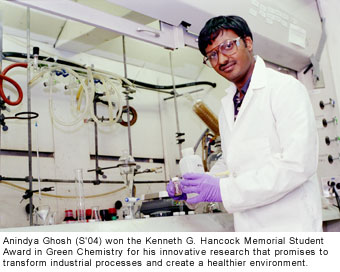For his innovative research that promises to transform industrial processes and create a healthier environment, Anindya Ghosh has won the Kenneth G. Hancock Memorial Student Award in Green Chemistry. Ghosh, a 2004 alumnus of the Mellon College of Science's (MCS) doctoral program in chemistry, was recognized for this achievement at the tenth annual Presidential Green Chemistry Challenge Awards Ceremony on June 20 at the National Academy of Sciences in Washington, D.C.

Before an audience of scientists, industrialists, regulators and policy leaders, American Chemical Society (ACS) Executive Director and Chief Executive Officer Madeleine Jacobs presented Ghosh with his Hancock Award. She expressed her admiration for his groundbreaking work, and for the work being done at Carnegie Mellon at the forefront of modern green chemistry.
“I am very proud of Anindya. He is a powerful chemist and a wonderful person," said Terry Collins, Thomas Lord Professor of Chemistry, director of the Institute for Green Oxidation Chemistry and Ghosh's advisor.
The Hancock Award is generally conferred upon only one person per year. Each winner receives a monetary sum and is recognized for his or her outstanding student contributions to furthering the goals of green chemistry through research or education. The Division of Environmental Chemistry of the ACS administers the Hancock Award program.
Green chemistry is the design of chemical products and processes that reduce or eliminate the use and generation of hazardous substances. It is based on 12 principles, including reduction of pollution, prevention of waste, design of safer chemicals and products, and minimization of potential for accidents.
Ghosh was selected as this year’s Hancock Award winner because of his central role in work with Fe-tetraamido macrocyclic ligand (Fe-TAML®) activators. The award recognizes Ghosh’s research to elucidate details of how Fe-TAML® activators work and to design and test Fe-TAML®s that can operate in a broad range of environments.
Fe-TAML® activators are catalysts, or substances that accelerate chemical reactions without being broken down in the reactions. Each Fe-TAML® activator molecule consists of an iron atom (Fe) surrounded by a TAML® ligand. The unique structure of Fe-TAML® activators enables them to join with hydrogen peroxide or oxygen to oxidize—thus disabling, rendering less toxic, or destroying—pollutants that contaminate water, air, and soil.
At the institute, Collins and his research group have designed, synthesized, and optimized Fe-TAML® activators so that they now serve as the mainstays in oxidation systems to make many industrial processes greener and to detoxify resources contaminated by less environmentally friendly processes.
Ghosh participated in development of Fe-TAML®s for many applications. These include Fe-TAML®s that can kill spores of a simulant of the known bioterrorism agent anthrax, which suggests that they also may be able to destroy actual anthrax. Fe-TAML®s also can purify water polluted by byproducts of textile, pulp, and paper mills, and they can remove recalcitrant sulfur compounds from fuels, making the fuels cleaner-burning and more efficient. Also, they can break down pesticides that, if left in soil and water, would develop into dioxins, chemicals associated with cancer and other health problems.
In 2003, Ghosh was one of only eight doctoral candidates awarded a $10,000 scholarship through the Teresa Heinz Scholars for Environmental Research program. With the support of this award, Ghosh became the first person to show that Fe-TAML®s with a ferric ion, a form of iron that has lost three electrons, can bind with and activate oxygen under ambient conditions. As well as its being scientifically unprecedented, this discovery means that Fe-TAML® activators may eventually be used in industry with oxygen. Oxygen is cheaper and more abundant than hydrogen peroxide, and could be used in everyday conditions, such as normal room temperature and pressure. This step should facilitate broader adoption of greener industrial processes involving Fe-TAML®s.
Before completing his Ph.D. in chemistry, Ghosh earned a bachelor of science degree at the Ramakrishna Mission Residential College, an affiliate of the University of Calcutta, and a master of science in chemistry from the Indian Institute of Technology at Kanpur. He is currently a postdoctoral researcher at the Center for Environmentally Beneficial Catalysis, a National Science Foundation Engineering Research Center at the University of Kansas.
Related Link:
The Institute for Green Oxidation Chemistry



